Related Research Articles

Alfonso the Magnanimous was King of Aragon and King of Sicily and the ruler of the Crown of Aragon from 1416 and King of Naples from 1442 until his death. He was involved with struggles to the throne of the Kingdom of Naples with Louis III of Anjou, Joanna II of Naples and their supporters, but ultimately failed and lost Naples in 1424. He recaptured it in 1442 and was crowned king of Naples. He had good relations with his vassal, Stjepan Kosača, and his ally, Skanderbeg, providing assistance in their struggles in the Balkans. He led diplomatic contacts with the Ethiopian Empire and was a prominent political figure of the early Renaissance, being a supporter of literature as well as commissioning several constructions for the Castel Nuovo.
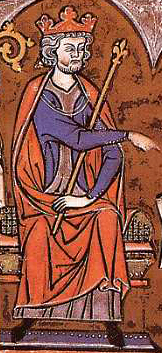
James I the Conqueror was King of Aragon, Count of Barcelona and Lord of Montpellier from 1213 to 1276; King of Majorca from 1231 to 1276; and King of Valencia from 1238 to 1276. His long reign of 62 years is not only the longest of any Iberian monarch, but one of the longest monarchical reigns in history, ahead of Hirohito but remaining behind Queen Elizabeth II, Queen Victoria and Ferdinand III of Naples and Sicily. He saw the expansion of the Crown of Aragon in three directions: Languedoc to the north, the Balearic Islands to the southeast, and Valencia to the south. By a treaty with Louis IX of France, he achieved the renunciation of any possible claim of French suzerainty over the County of Barcelona and the other Catalan counties, while he renounced northward expansion and taking back the once Catalan territories in Occitania and vassal counties loyal to the County of Barcelona, lands that were lost by his father Peter II of Aragon in the Battle of Muret during the Albigensian Crusade and annexed by the Kingdom of France, and then decided to turn south. His great part in the Reconquista was similar in Mediterranean Spain to that of his contemporary Ferdinand III of Castile in Andalusia. One of the main reasons for this formal renunciation of most of the once Catalan territories in Languedoc and Occitania and any expansion into them is the fact that he was raised by the Knights Templar crusaders, who had defeated his father fighting for the Pope alongside the French, so it was effectively forbidden for him to try to maintain the traditional influence of the Count of Barcelona that previously existed in Occitania and Languedoc.
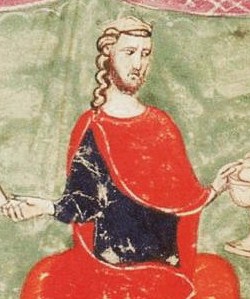
Peter III of Aragon was King of Aragon, King of Valencia, and Count of Barcelona from 1276 to his death. At the invitation of some rebels, he conquered the Kingdom of Sicily and became King of Sicily in 1282, pressing the claim of his wife, Constance II of Sicily, uniting the kingdom to the crown.
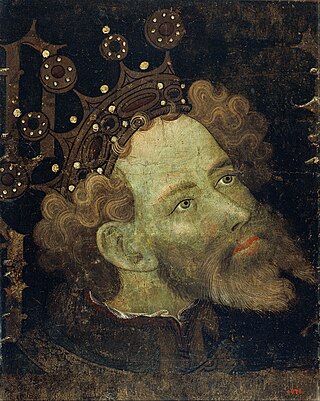
Peter IV, called the Ceremonious, was from 1336 until his death the king of Aragon, Sardinia-Corsica, and Valencia, and count of Barcelona. In 1344, he deposed James III of Majorca and made himself King of Majorca.

Frederick II ; 13 December 1272 – 25 June 1337) was the regent of the Kingdom of Sicily from 1291 until 1295 and subsequently King of Sicily from 1295 until his death. He was the third son of Peter III of Aragon and served in the War of the Sicilian Vespers on behalf of his father and brothers, Alfonso ΙΙΙ and James ΙΙ. He was confirmed as king by the Peace of Caltabellotta in 1302. His reign saw important constitutional reforms: the Constitutiones regales, Capitula alia, and Ordinationes generales.

Charles II, also known as Charles the Lame, was King of Naples, Count of Provence and Forcalquier (1285–1309), Prince of Achaea (1285–1289), and Count of Anjou and Maine (1285–1290); he also was King of Albania (1285–1294), and claimed the Kingdom of Jerusalem from 1285. He was the son of Charles I of Anjou—one of the most powerful European monarchs in the second half of the 13th century—and Beatrice of Provence. His father granted Charles the Principality of Salerno in the Kingdom of Sicily in 1272 and made him regent in Provence and Forcalquier in 1279.

The Kingdom of Naples was a state that ruled the part of the Italian Peninsula south of the Papal States between 1282 and 1816. It was established by the War of the Sicilian Vespers (1282–1302), when the island of Sicily revolted and was conquered by the Crown of Aragon, becoming a separate kingdom also called the Kingdom of Sicily. This left the Neapolitan mainland under the possession of Charles of Anjou. Later, two competing lines of the Angevin family competed for the Kingdom of Naples in the late 14th century, which resulted in the death of Joanna I by Charles III of Naples. Charles' daughter Joanna II adopted King Alfonso V of Aragon as heir, who would then unite Naples into his Aragonese dominions in 1442.

James II, called the Just, was the King of Aragon and Valencia and Count of Barcelona from 1291 to 1327. He was also the King of Sicily from 1285 to 1295 and the King of Majorca from 1291 to 1298. From 1297 he was nominally the King of Sardinia and Corsica, but he only acquired the island of Sardinia by conquest in 1324. His full title for the last three decades of his reign was "James, by the grace of God, king of Aragon, Valencia, Sardinia and Corsica, and count of Barcelona".

The Kingdom of Majorca was a realm on the east coast of Spain, which included certain Mediterranean Islands, and which was founded by James I of Aragon, also known as James the Conqueror. In a will written in 1262 after the death of his firstborn son Alfonso, he ceded the kingdom to his son James. The disposition was maintained during successive versions of his will and so when James I died in 1276, the Crown of Aragon passed to his eldest son Peter, known as Peter III of Aragon or Peter the Great. The Kingdom of Majorca passed to James, who reigned under the name of James II of Majorca. After 1279, Peter III of Aragon established that the King of Majorca was a vassal to the king of Aragon. In 1344 the kingdom was brought under the Crown of Aragon, remaining a constituent kingdom until its dissolution in 1715 by one of the Nueva Planta decrees.

The Kingdom of Sicily was a state that existed in Sicily and the south of the Italian Peninsula plus, for a time, in Northern Africa from its founding by Roger II of Sicily in 1130 until 1816. It was a successor state of the County of Sicily, which had been founded in 1071 during the Norman conquest of the southern peninsula. The island was divided into three regions: Val di Mazara, Val Demone and Val di Noto.

The Crown of Aragon was a composite monarchy ruled by one king, originated by the dynastic union of the Kingdom of Aragon and the County of Barcelona and ended as a consequence of the War of the Spanish Succession. At the height of its power in the 14th and 15th centuries, the Crown of Aragon was a thalassocracy controlling a large portion of present-day eastern Spain, parts of what is now southern France, and a Mediterranean empire which included the Balearic Islands, Sicily, Corsica, Sardinia, Malta, Southern Italy, and parts of Greece.

James II was King of Majorca and Lord of Montpellier from 1276 until his death. He was the second son of James I of Aragon and his wife, Violant, daughter of Andrew II of Hungary. In 1279, by the Treaty of Perpignan, he became a vassal of the Crown of Aragon.

Spain in the Middle Ages is a period in the history of Spain that began in the 5th century following the fall of the Western Roman Empire and ended with the beginning of the early modern period in 1492.
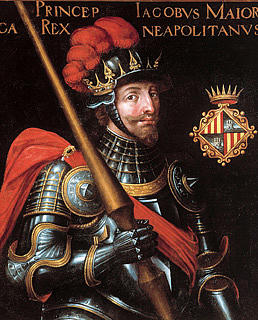
James IV of Majorca, also known as Jaume IV, unsuccessfully claimed the thrones of the Kingdom of Majorca and the Principality of Achaea from 1349 until his death. He was also king consort of Naples, without any role in its government.

The Aragonese Crusade (1284–1285), also known as the Crusade of Aragon or Crusade against Catalonia, was a military venture waged by the Kingdom of France against the Crown of Aragon. Fought as an extension of the War of the Sicilian Vespers (1282–1302), the crusade was called by Pope Martin IV in retribution for Peter III of Aragon's intervention in Sicily, which had damaged the political ambitions of the papacy and France.
The Treaty of Tarascon was an accord between Pope Nicholas IV, Philip IV of France, Charles II of Naples, and Alfonso III of Aragón that was intended to end the Aragonese Crusade, an episode in the War of the Sicilian Vespers. The treaty was signed at Tarascon, halfway between papal Avignon and Arles, on 19 February 1291, six years after Philip's brother, Charles of Valois, tried to conquer Aragón from Alfonso's father, Peter III of Aragon, in an event called the Aragonese Crusade because it was sanctioned by Nicholas' predecessor, Pope Martin IV. The intent of the signatories in putting an end to hostilities was to prevent Aragonese domination of Sicily, then ruled by Alfonso's brother, James II.

Raymond Berengar of Anjou was the count of Andria and possibly Count of Provence and Prince of Piedmont.

The War of the Sicilian Vespers, also shortened to the War of the Vespers, was a conflict waged by several medieval European kingdoms over control of Sicily from 1282 to 1302. The war, which started with the revolt of the Sicilian Vespers, was fought over competing dynastic claims to the throne of Sicily and grew to involve the Crown of Aragon, Angevin Kingdom of Naples, Kingdom of France, and the papacy.
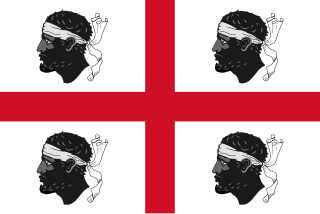
The Kingdom of Sardinia, also referred to as the Kingdom ofSardinia-Piedmont, Sardegna and Corsica or Piedmont–Sardinia as a composite state during the Savoyard period, was a country in Southern Europe from the late 13th until the mid-19th century ; officialy 1297 to 1768 for the corsican part of this kingdom.

The First War of Sicily was a protracted conflict for control of the Kingdom of Sicily and naval dominance in the Mediterranean, spanning from 1282 to 1302. This article focuses on the initial phase of the war (1282–1294), fought between the Crown of Aragon and the House of Anjou, which held power in Naples and France. For the main article on the conflict, see War of the Sicilian Vespers.
References
- ↑ Yun, Bee (2008). "Ptolemy of Lucca — a Pioneer of Civic Republicanism? A Reassessment". History of Political Thought. 29 (3): 417–439. ISSN 0143-781X. JSTOR 26224029.
- ↑ Pryds, Darleen N. (2000-01-01), "The Divine Edge to Earthly Politics: The World that Robert Inherited", The King Embodies the Word: Robert d'Anjou and the Politics of Preaching, Brill, pp. 21–31, doi:10.1163/9789004474826_005, ISBN 978-90-04-47482-6 , retrieved 2023-11-02